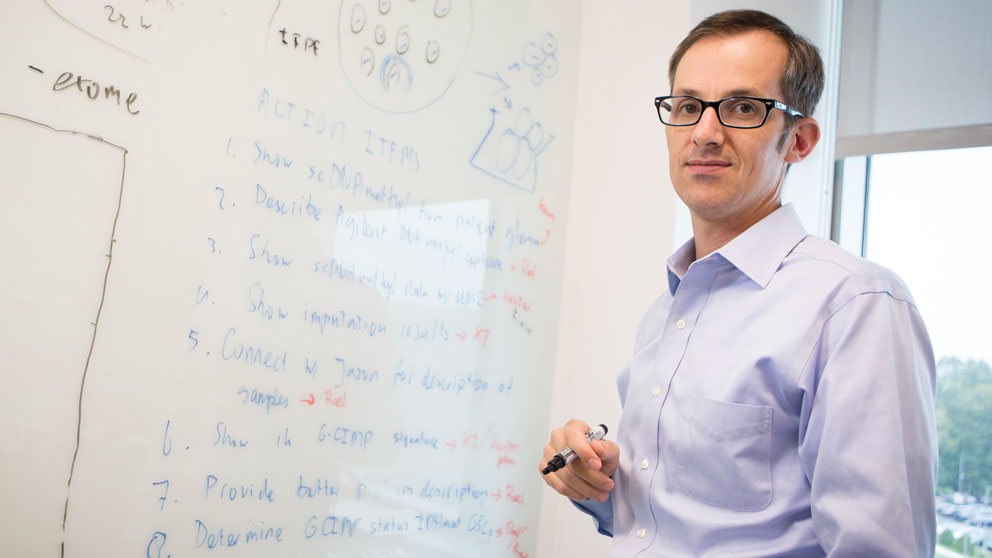
Recent advances in cancer research have revealed much more about just how complex cancer is and how difficult it is to completely cure.
It can be sobering to confront the challenges ahead. Day by day researchers better understand why my cancer is not your cancer, and one-size-fits-all therapies seem less and less realistic.
So is the cancer research picture bleak? Far from it! Targeted therapies will yield huge gains, with fewer severe side effects, compared to the sledgehammer chemotherapeutic and radiation approaches — which kill almost all quickly dividing cells — currently serving as the standard of care. It just helps to be realistic about progress and accept that success is unlikely to yield “cures” for cancer, at least not in the near future. Nonetheless, it is likely to provide far better prognoses for a large number of cancer patients.
For a better handle on where we are now, what challenges remain to be overcome, and what progress may be around the corner, here are a few key biological concepts, how they relate to cancer, and research at the The JAX Cancer CenterThe Jackson Laboratory Cancer Center (JAXCC) is a National Cancer Institute-designated Cancer Center complemented by institutional education, resource and service initiatives that support cancer research world-wide. The JAXCC comprises approximately 50 members with multidisciplinary expertise who are united in research aimed at understanding and targeting the genomic complexity of cancer.NCI-designated Jackson Laboratory Cancer Center that is increasing our understanding of each concept and, in some cases, is identifying new therapeutic targets.
Understanding the keys to cancer cell growth and survival
Cancer cells, even within the same tumor, can be different in important ways. The technical term is heterogeneous, and the consequences of heterogeneity started coming into focus only a few years ago. At that time, researchers showed that cells collected from four different regions of the same kidney cancer tumor were in fact quite different. Further studies have reinforced this finding, and cancer cell heterogeneity is now widely recognized. Given that biopsies are typically taken from a single spot within a tumor, this fact has serious implications for improving diagnostics and therapies. It also indicates that any one targeted therapy is highly unlikely to eliminate all cancer cells by itself.
Research into cancer cell variation at JAX
The recently established What is single cell genomics?Recent advances in the techniques for isolating single cells, together with methods for amplifying their genetic material, now make it possible to explore the genomes of single cells. Single Cell Genomics Center at JAX Genomic Medicine, led by Paul Robson, Ph.D.Areas of expertise include single cell transcriptomics, primate/human early embryonic development, maternal-fetal medicine, fetal programming, pluripotent cell biology, regulatory networks, tumor heterogeneity, circulating tumor cells.Paul Robson, Ph.D., provides a powerful new platform for investigating cancer. There are many possible applications, but it’s easy to see that focusing on one cell at a time provides a way to identify, characterize and better understand the effects of cellular differences within tumors. Single-cell sequencing can track how mutations spread through tumors and make some of them resistant to therapy. The technology also provides the opportunity to uncover molecules that control cell-to-cell communication between the many cell types that reside within a tumor, identifying potential drug targets. And it has the potential to reveal cell types that are rare or otherwise difficult to study but are important to cancer growth and survival.
What makes cancer cells survive and thrive? Evolution.
Cancer cells grow and divide with extreme rapidity and must endure a certain amount of stress and damage to their DNA. Fast-growing cancers depend on a fine balance between DNA damage and repair, but genetic changes add up over time, and the result is like evolution at warp speed, where growth-promoting mutations lead to even more rapid expansion. This contributes to the heterogeneity discussed above. It also means the cancer you find today may differ from the one you try to treat in the weeks and months to come. With modern sequencing and analysis, it’s now possible to track cancer cell evolution and begin to predict the changes before they occur. Nonetheless, it’s much harder to hit a moving target than a stationary one, and even a highly effective, precisely targeted combination of therapies may not succeed if enough cancer cells survive initial treatment and further evolve.
Research into cancer cell evolution at JAX
Glioblastoma is an aggressive brain cancer that remains extremely difficult to treat. Sadly, fewer than 10% of patients live past five years post-diagnosis. Professor and Associate Director of Computational Biology , is using data-intensive computational methods to characterize glioblastoma with far more precision and greater detail than previously possible, with the goal of finding its weaknesses and develop effective therapies. Recent work has included refining the Glioblastoma ‘ecosystem’ redefined for more effective immunotherapy trialsA JAX-led research team detects gene expression patterns distinct from those of the surrounding immune cells, and characterizes the effects of chemotherapy and radiation treatments.classification of glioblastoma sub-types , as global differences between types provide important therapeutic clues. He also works at the single-cell level to track differences over time in both glioblastoma cells and in their micro-environments, the tissues and cells immediately surrounding the cancer cells. Learning how both change and evolve under selective pressure such as during treatment is vital for refining therapy regimens. And because their micro-environments can help cancer cells evade therapy, extending analyses beyond the glioblastoma cells themselves is a Profiling brain cancers for more targeted treatmentsProfessor Roel Verhaak, Ph.D., is focused on the analysis of cancer genomics data to improve our understanding of cancer biology. vital step forward .
Structural variation in cancer-causing genes
Structural variants and the limits of genome sequencesGenome sequences tell us a lot, but structural variations are also key players in health and disease.Structural variants include duplications, deletions, inversions and insertions of stretches of DNA, changes in the genome that don’t change the sequence per se but can have significant consequences. While most structural variants are hard to detect and details about them are just beginning to emerge, the role of a particular structural variant in cancer has been known for a very long time. Researchers discovered the famous Philadelphia chromosome, which gives rise to chronic myeloid leukemia (CML), in 1960. Structural variants add to the list of genetic changes that can tip the balance toward cancerous growth through overexpression of duplicated oncogenic (cancer-causing) genes, underexpression of deleted cancer suppressor genes and other insertions/translocations giving rise to oncogenic proteins.

Research into structural variation at JAX
Although it can be relatively easy to find structural variants that involve long segments of DNA, such as the Philadelphia chromosome, many elude standard sequencing and analysis methods. JAX Genomic Medicine Scientific Director and Professor Charles Lee, Ph.D., FACMGThe study of structural genomic variation in human biology, evolution and disease.Charles Lee, Ph.D. , helped pioneer structural variant research and discovered that such variants are common in healthy people. Indeed, Lee contributed significantly to a thorough catalog of structural variants in thousands of human genomes. Lee’s work extends to improving the understanding of the roles of structural variants in cancer as well. In gastric cancer, which currently has a poor prognosis, revealed that a significant percentage of patient tumors had additional copies of a gene, BCL2L1, that prevents cells from self-destructing. Thus, even in conditions that would normally initiate the self-destruct process, a cell will continue to grow and divide and be very susceptible to turning cancerous. Lee also found that a drug that inhibits BCL2L1 functions in cancer cells. It allowed the self-destruct process to reactivate, leading to cell death, making it a promising new therapeutic target for gastric cancer.
Cancer cells can hide in plain sight
Cancer cells, although different in many ways from other cells in the body, are known to evade our immune system or suppress key elements of the usual immune response. In some cases aggressive cytotoxic (killer) T cells — the immune cells that locate and kill invading pathogens — actually infiltrate tumors. For some reason, however, they soon halt their attack through a combination of cell-to-cell signaling and an influx of T regulator cells, a different type of immune cells that suppress the immune response. Other research found that a chemical compound is sometimes added to cancer cell DNA and suppresses the activity of certain genes, making the cells much less likely to be targeted by the immune system. By controlling the activity of these genes, cancer is able to hide in plain sight within the body and avoid an immune response.
Cancer immunotherapy research at JAX
Cancer immunotherapy, using the body’s own immune system to target and destroy cancer cells, is one of the most exciting fields in biomedical research. The excitement is merited, and there have been spectacular successes in human patients. But challenges remain — many patients don’t respond to the therapies for reasons not fully understood, and there have been some issues with toxicity following too strong an immune response. JAX Professor Karolina Palucka, M.D., Ph.D.Conducts research to understand how vaccines work and to define precisely the immune mechanisms that underlie vaccination, with a focus on cancer immunotherapies.Karolina Palucka, M.D., Ph.D. , is working to better understand the complex interplay between the human immune system and cancer. To do this, she is developing a special mouse system that provides an experimental model using both human tumor tissue and human immune cells. She is also investigating how to increase response to a class of drugs — checkpoint inhibitors — that block immune cell inhibition and promote cancer cell destruction. One method is to enhance the expansion or activation of killer T cells through cancer vaccines. It’s a delicate balance, as overstimulation can lead to the toxic side effects mentioned previously, but careful manipulation can yield an extremely effective cancer-destroying response.
Cancer remains a difficult disease to treat, but the emerging therapies are increasingly effective. As we approach a new decade, it is interesting to speculate what we will be able to do when we move into the 2020s. What therapies will be available that seem out of reach today? While outright cures will likely remain elusive, we may be poised at the brink of an important step or even leap forward in our ability to treat cancer nonetheless. Cancer’s complexity will not go away, but our ability to understand and manipulate cancer cells — as well as suppress and kill them — will continue to accelerate.
A faster way to fight cancer
The story of Kelsey Gallagher highlights the hope and the limitations of current therapies for cancer. The future of cancer treatment lies in more personalized, precise medicine, fueled by the latest scientific advances. The Jackson Laboratory is using genomics and cancer avatars to identify, faster and with greater precision, which treatments will be effective in the individual patient.